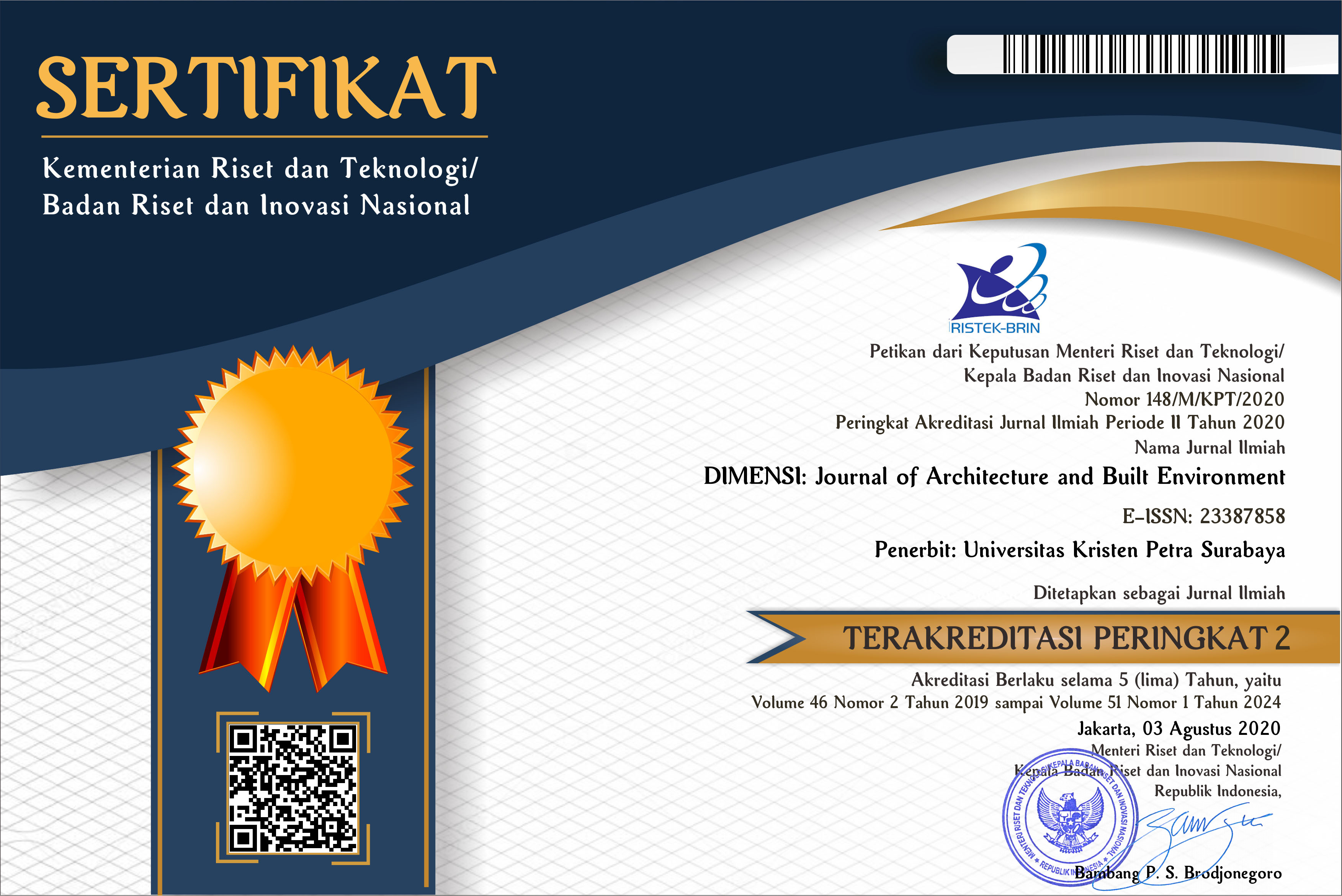STUDY OF HORIZONTAL LIGHT PIPE WITH DYNAMIC REFLECTOR IN THE TROPICS
 :
:
https://doi.org/10.9744/dimensi.49.1.75-86
Keywords:
Horizontal Light Pipe, reflector tilt angle, daylight qualityAbstract
Horizontal light pipe (HLP) is a sustainable strategy for improving daylighting quality in buildings. The reflector is one of the HLP elements that collect and direct the incoming light in the pipe. Several reflector studies of HLP systems have been carried out in the last three decades under specific sunlight conditions at certain altitudes and azimuths or static conditions. This study proposes a dynamic reflector model in response to the movement of the sun angle. This study aimed to examine the impact of the dynamic reflector tilt angle on improving the quality of light by adapting the sun angle. The method used is an experimental simulation using IESVE software. This research is located in Surabaya, with a tropics climate. The results showed that modifying the reflector to be dynamic could increase the illuminance levels up to 29.9%, daylight factor values up to 29.2%, and uniformity ratio values up to 33.3%.
Downloads
References
Alrubaih, M. S., Zain, M. F. M., Alghoul, M. A., Ibrahim, N. L. N., Shameri, M. A., & Elayeb, O. (2013). Research and development on aspects of daylighting fundamentals. Elsevier, 21, 494–505.
Beltran, L. O., Lee, E. S., & Selkowitz, S. E. (1997). Advanced optical daylighting systems: Light shelves and light pipes. Taylor & Francis Online, 91–106. https://doi.org/10.2172/406122
Brasington, L. (2019, June). Heating, ventilation and air conditioning (HVAC) systems, the next building load to optimize | Cleantech Group. https://www.cleantech.com/heating-ventilation-and-air-conditioning-hvac-systems-the-next-building-load-to-optimize/
Canziani, R., Peron, F., & Rossi, G. (2004). Daylight and energy performances of a new type of light pipe. Elsevier, 36(11), 1163–1176.
Elsiana, F., Ekasiwi, S. N. N., & Antaryama, I. G. N. (2021). Integration of horizontal light pipe and shading systems in office building in the tropics. Tamkang University Press, 25(1), 231–243.
Galatioto, A., & Beccali, M. (2016). Aspects and issues of daylighting assessment: A review study. Elsevier, 66, 852–860.
Hansen, G., & Edmonds, I. (2003). Natural illumination of deep-plan office buildings: Light pipe strategies. QUT, 10.
Heng, C. Y. S., Lim, Y.-W., & Ossen, D. R. (2020). Horizontal light pipe transporter for deep plan high-rise office daylighting in tropical climate. Elsevier, 171, 1–13.
Kristanto, L. (2021, November). Energy Efficient Lighting. Lighting Terapan.
Linhart, F., Wittkopf, S. K., & Scartezzini, J.-L. (2010). Performance of anidolic daylighting systems in tropical climates – Parametric studies for identification of main influencing factors. Elsevier, 84(7), 1085–1094.
Obradovic, B., & Matusiak, B. (2021). A customised method for estimating light transmission efficiency of the horizontal light pipe via a temporal parameter with an example application using lasercut panels as a collector. MethodsX, 8, 101339. https://doi.org/10.1016/j.mex.2021.101339.
Obradovic, B., Matusiak, B. S., Klockner, C. A., & Arbab, S. (2021). The effect of a horizontal light pipe and a custom-made reflector on the user’s perceptual impression of the office room located at a high latitude. Energy and Buildings, 253, 111526. https://doi.org/10.1016/j.enbuild.2021. 111526
Oleiwi, M. Q., Mohamed, M. F., Sulaiman, M. K. A. M., Che-Ani, A. I., & Raman, S. N. (2019). Thermal environment accuracy investigation of Integrated Environmental Solutions-Virtual Environment (IES-VE) software for double-story house simulation in Malaysia. Medwell, 14(11), 3659–3665.
Preto, S., & Gomes, C. C. (2018). Lighting in the workplace: Recommended illuminance (Lux) at workplace environs. Springer Link, 776, 180–191.
Ruck, N. C., & Aschehoug, O. (2000). Daylight in Buildings: A source book on daylighting systems and components. International Energy Agency.
Sassi, P. (2006). Strategies for sustainable architecture. Taylor & Francis.
Sinha, A. (2021, March). Difference Between Equinox and Solstice in Tabular Form. Physics In My View. https://physicsinmyview.com/2021/03/ equinox-and-solstice-difference.html
Vaisi, S., & Kharvari, F. (2019). Evaluation of Daylight regulations in buildings using daylight factor analysis method by radiance. Energy for Sustainable Development, 49, 100–108. https://doi.org/10.1016/j.esd.2019.02.002
Wong, I. L. (2017). A review of daylighting design and implementation in buildings. Elsevier, 74, 959–968.
Zain-Ahmed, A., Sopian, K., Zainol Abidin, Z., & Othman, M. Y. H. (2002). The availability of daylight from tropical skies—A case study of Malaysia. Elsevier, 25(1), 21–30.
Downloads
Published
How to Cite
Issue
Section
License
Authors who publish with this journal agree to the following terms:
- Authors retain copyright and grant the journal right of first publication with the work simultaneously licensed under a Creative Commons Attribution License that allows others to share the work with an acknowledgement of the work's authorship and initial publication in this journal.
- Authors are able to enter into separate, additional contractual arrangements for the non-exclusive distribution of the journal's published version of the work (e.g., post it to an institutional repository or publish it in a book), with an acknowledgement of its initial publication in this journal.
- Authors are permitted and encouraged to post their work online (e.g., in institutional repositories or on their website) prior to and during the submission process, as it can lead to productive exchanges, as well as earlier and greater citation of published work (See The Effect of Open Access).


















